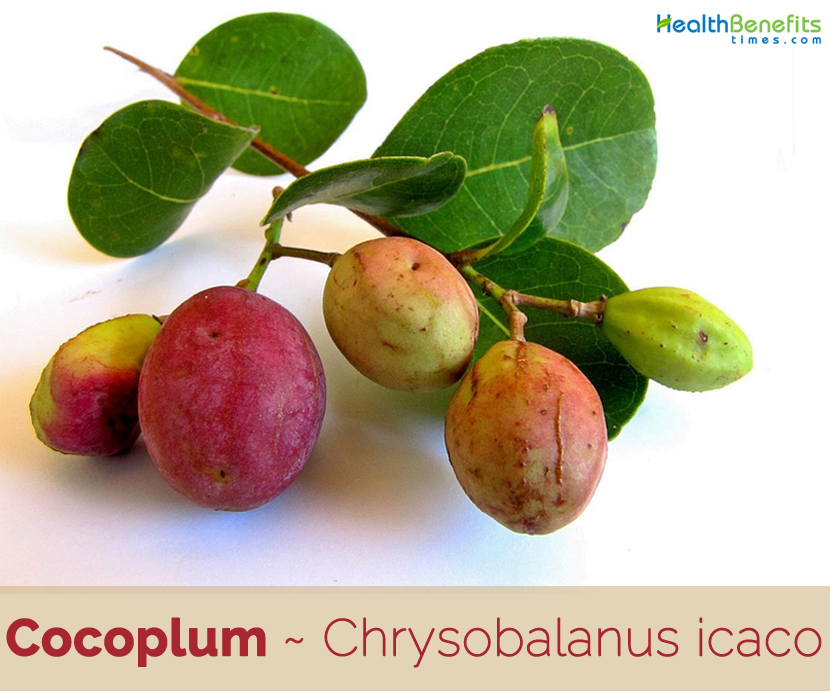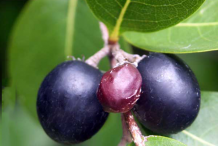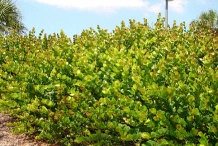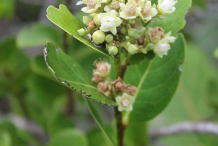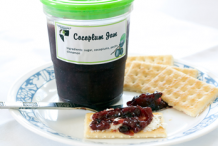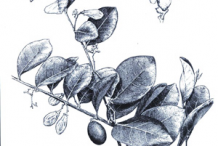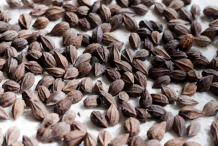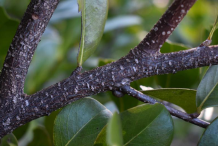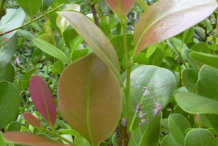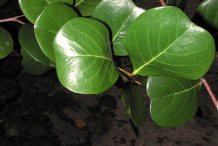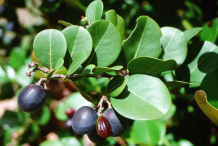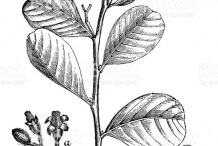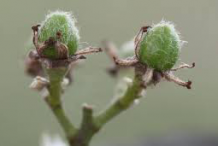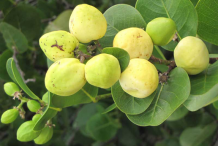Plant description
Cocoplum is a bushy, slow-growing, small evergreen tree or a low growing, sprawling shrub. As a shrub it grows about 1–3 meters (3.3–9.8 ft.), or bushy tree 2–6 meters (6.6–19.7 ft.), rarely to 10 meters (33 ft.) tall. The plant is thrives in different habitats including cypress swamps, low areas, tree islands, beaches, sand dunes, canals, riverside, Oceanside thickets, hammocks, by lakes, ponds, landscaping, moist forest, swamps and coastal beaches. The plant is found growing in acidic to alkaline, clay to sandy, seasonally saturated to seasonally dry soils. Shoot is green and smooth and may be produced year-round. As they age, they become brown, hardened, and stiff, developing several conspicuous raised, elliptic, white, or tan lenticels. Bark is greyish or reddish brown, with white specks.
Leaves
Cocoplum leaves are alternate, simple, and entire. They point upwards, forming a V-shaped angle along the upper side of the stem. The blades are mostly 1.5 to 3.50 inches long, broadly elliptic, obovate (wider above the middle) or nearly round, and attached to a short petiole, nearly 0.125 inches long. The tips may be slightly pointed, rounded, or notched. Base usually tapers to a point or is obtuse or rounded. Margins are thinly and tightly revolute (rolled under), which can be felt by moving a finger across the lower leaf margins. New leaves are thinner-textured, yellowish-green or often red-tinged. With age, they become leathery, smooth, shiny, and dark-green on the upper surface and a paler, matte green below. Mid veins are lighter colored and prominent, except toward the distal (uppermost) portion of the blades.
Flowers
Flowering is mostly from January to August, but the main flowering period is usually late spring. Flowers occur in inconspicuous, short, axillary, and terminal clusters called cymules (few-flowered, poorly branched inflorescences in which the central flower matures first). Each flower is perfect (with both male and female sexual organs), and measures about 0.25 inch long. The five distinct (unfused), spreading, pale greenish-to-yellowish sepals and five narrow, white petals are borne atop a conical receptacle (flower base or axis).The stamens vary in number from 12 to 25, and are irregularly fused into an erect, densely hairy tube in the center of the flower. Ovary is also shaggy and hairy, but the hairs are lost as the fruit develops.
Fruits
Fruiting is abundant from late spring through summer. Immature and mature fruit are often found on the same fruiting cluster. Immature fruit are green and become purple, white, or white-blushed pink when mature. They do not ripen when picked prematurely. Mature fruit easily detach from the stem and fall below the plant or are removed by people or wildlife. They are soft and edible, slightly sweet and pleasant tasting, while others are somewhat insipid.
Fruits are thin-skin globular to ovoid drupes on short pedicels and measure up to 3–5 cm (1.2–2 in) long. ‘Horizontal’ fruit is white, white with pink blush, or (less often) purple. They are round, typically up to 1.5 inches in diameter. ‘Red Tip’ has oblong purple fruit. ‘Green Tip’ has white (or occasionally purple) oblong or rounded fruit. Both inland cultivars have smaller drupes than their coastal counterpart, mostly 0.75 inches in diameter. The white cottony pulp surrounds a single pit with a hard endocarp, bearing 4 to 8 longitudinal ribs.
History
The plant is native to coastal areas of central and south Florida, the West Indies, Mexico, Central America, South America, and West and Central Africa. The plant may also be indigenous to the coasts of western Africa. It grows naturally in coastal swamps and along beaches. The coco plum has been introduced and naturalized in coastal areas of many tropical countries. On some islands like Fiji and French Polynesia the plant has become invasive and poses a threat to native ecosystems. Nowadays it is found in several parts of the world due to its amazing health benefits.
Cultivars
A cultivar is a plant variety purposefully bred or selected by humans for its distinctive characteristics. They may not produce true to type when grown from seeds. Thus, cultivars are mostly produced clonally from stem cuttings or tissue culture. This method of plant propagation guarantees plants will have the same characteristics as the parent plant.
1. Horizontal
‘Horizontal’ is the cultivar synonymous with the coastal form of cocoplum. There are no other coastal ecotypes known. When grown in close proximity to the inland forms, hybridization occurs. As its name suggests, ‘Horizontal’ has a sprawling growth habit. For this reason, it is used mostly as a groundcover, but also makes an excellent hedge. Its new leaves are light-green to yellow-green, and mature fruit are predominantly white, white blushed with pink, or (less often) purple. This cultivar was once called “Hobe Sound cocoplum” because it was found at that location in coastal Martin County. It has also been called “dwarf cocoplum,” which is misleading because it is not a dwarf selection. It typically does not exceed a height of six feet.
2. ‘Red Tip,’ ‘Green Tip’
‘Red Tip’ is a cultivar of the inland form of cocoplum. The color of the new leaf growth is burgundy-red, becoming yellowish-green and then dark-green. Mature fruit color is usually purple. This cultivar has become the dominant cocoplum hedge of south Florida. There is also reference to a ‘Green Tip’ cultivar. This may simply be a way of describing plants of the inland ecotype without the burgundy-red new growth. They have light-green new leaves that become dark-green. Mature fruit color is mostly white and often blushed with pink. Both cultivars are capable of growing up to 25 feet or more in height.
Health benefits of Cocoplum
There are different opinions about eating the cocoplum fruit. Some find it quite tasty while others do not like the taste of the white pulp. Whether the blue tastes better than the white pulp, cocoplums have different health benefits. Listed below are few of the popular health benefits of consuming cocoplum
1. Build Cell Membranes
Cocoplums are very rich in lipoprotein cholesterol levels. This high level is considered beneficial to = build and sustain cell membranes. It also prevents the development of hypercholesterolemia and improves cell signaling that supports the B-cell and other immune functions.
2. Combat cancer
Cocoplum is considered the best fruit for preventing cancer. According to research, the cocoplum has epicatechin which helps slow down cell growth of cancer. Besides, cocoplums are rich in antioxidants, chlorogenic acid, and phytonutrients are natural nutrients that help combat cancer cells.
3. Reduce Risk of Heart attack
Cocoplums are excellent sources of nutrients that improve the health of the heart. Dried plums boost blood fluidity, in turn, decreasing the risk of heart attacks. Furthermore, cocoplums help reduce the risk of strokes and treat atherosclerosis.
4. Improve Vision
Cocoplums help improve the health of your eyes. They are loaded with beta-carotene and vitamin A which play this role perfectly. Additionally, eating cocoplums help put off muscular degeneration therefore protecting the cornea from the harmful UV rays.
5. Improve skin health
Just like other plums, the fruits of this plant are rich in vitamin C and other antioxidants that are helpful for the skin. Including cocoplums in your diet regularly guarantee you a smooth and radiant skin. Aside from this, cocoplums also rid your skin of dark spots and cure acne.
6. Pregnant women
Pregnant women will benefit the most from eating cocoplums regularly. Fruits of this plant have several vitamins and minerals that are useful during pregnancy. They are equally rich in fiber which encourages digestion and alleviates constipation.
7. Healthy Bones
If you want to maintain healthy bones, then you need to consider cocoplums as part of your daily diet. These fruits consist of vitamin K which is essential for keeping bones healthy and correcting weak bones in the body.
Other benefits
Research hints that consumption of dried cocoplums help in weight loss. Aside from this, cocoplums are an excellent remedy for anxiety. Many people recommend eating cocoplums because they also help sustain the electrolyte balance in the body. Finally, cocoplums have essential minerals like copper and iron which help maintain healthy blood circulation.
Traditional uses and benefits of Cocoplum
- Root, stem-bark and leaf are astringent and are used for diarrhea and leucorrhoea.
- Juice mixed with oil is used to contract the sphincters of the vulva by women wishing to simulate virginity, and the same preparation is used by men for treating flaccid scrotum in French Guiana.
- It is used internally against dysentery, dyspepsia, and diarrhea and externally against various skin conditions.
- They are used externally as a wash to treat skin complaints.
- They enclose a reasonable quantity of beta carotene as well as vitamin A, which are essential for our eyes to function healthily.
- Cocoplums are also excellent for the health of the heart. It is said that consumption of dried cocoplums helps to enhance fluidity of the blood, thereby lessening the risks of developing heart attacks.
- Eating cocoplums can also help to avoid as well as treat atherosclerosis and, also reduce the risks of strokes and heart attacks.
- Healthy cholesterol level in cocoplums is useful in preventing the development of hyperlipidemia and hypercholesterolemia.
- An elevated amount of vitamin C found in cocoplums is highly beneficial for our immune system.
- Consumption of cocoplums may delay the tumor cell metastasis.
- Essential minerals like iron and copper found in cocoplum is useful for maintaining a healthy blood circulation as well as purifying the blood.
- Iron and copper in cocoplums are also useful in putting off the onset of various ailments, such as anemia.
- Decoction of the roots, flowers and bark was described as anti-leucorrhoea.
- Leaves were administered against sore throats and in enema against intestinal disorders.
- Decoction of the leaves or roots was also used to tighten the female organs and simulate virginity.
Culinary uses
- Sweet fresh fruits, although somewhat dull, are eaten out of hand.
- Seed can be eaten raw also or roasted.
- Fresh fruits can be excellent for making jams and jellies.
- Seeds inside the pit can be roasted and eaten for their almond-like flavor or crushed and added to the jelly.
- Nectar from the flowers produces a dark-colored honey.
- Boiled fruits are made into a sweet preserve and eaten as dessert in Cuba.
Other facts
- They are particularly well suited for use by the sea.
- Seeds are so rich in oil that they can be strung on sticks and burnt like a candle.
- Black dye can be obtained from the fruit.
- Black dye can be obtained from the leaves.
- Oil in the kernel is an excellent substitute for almond oil and has also been used to make soap, candles and axle grease.
- It is also planted along beaches to prevent soil erosion.
References:
https://www.itis.gov/servlet/SingleRpt/SingleRpt?search_topic=TSN&search_value=25148#null
https://davesgarden.com/guides/pf/go/67612/
http://www.hear.org/pier/species/chrysobalanus_icaco.htm
https://npgsweb.ars-grin.gov/gringlobal/taxonomydetail.aspx?id=10397
https://pfaf.org/user/Plant.aspx?LatinName=Chrysobalanus+icaco
https://www.cabi.org/isc/datasheet/13122
http://www.theplantlist.org/tpl1.1/record/kew-367588
https://plants.usda.gov/core/profile?symbol=CHIC
https://en.wikipedia.org/wiki/Chrysobalanus_icaco
http://edis.ifas.ufl.edu/ep553
Comments
| Cocoplum Quick Facts | |
|---|---|
| Name: | Cocoplum |
| Scientific Name: | Chrysobalanus icaco |
| Origin | Coastal areas of central and south Florida, the West Indies, Mexico, Central America, South America, and West and Central Africa |
| Colors | Green when young and become purple, white, or white-blushed pink as they matures |
| Shapes | Thin skinned, globular to ovoid drupe measure up to 3–5 cm (1.2–2 in) long |
| Flesh colors | Cottony white |
| Taste | Almost tasteless to mildly sweet |
| Health benefits | Build Cell Membranes, Combat cancer, Reduce Risk of Heart attack, Improve Vision , Improve skin health, Beneficial for Pregnant women, Healthy Bones |
| Name | Cocoplum |
|---|---|
| Scientific Name | Chrysobalanus icaco |
| Native | Coastal areas of central and south Florida, the West Indies, Mexico, Central America, South America, and West and Central Africa |
| Common Names | Abajeru, Coco plum, Icaco, fat-pork, hog plum, pruim, spanish nectarine, Paradise Plum, icaco |
| Name in Other Languages | English: Coco plum, Icaco, fat-pork, hog plum, pruim, spanish nectarine, Paradise Plum, icaco Fijian: Apolo French: Icacier, Icaquier, Prune colon, gros icaque, icaque blanc, pomme icaque, prune coton, prune de Guyane, prune des icaques, prune icaque, prunier coton German: Icacopflaume Italian: prugna d’icaco Portuguese: Ajurú-branco, Guajiru, Spanish: Ciruela de algodón, Icaco, hicaco, icaco dulce, icaco negro, jicaco Swedish: Icaco |
| Plant Growth Habit | Bushy, slow-growing, small evergreen tree or a low growing, sprawling shrub |
| Growing Climates | Thrives in different habitats including cypress swamps, low areas, tree islands, beaches, sand dunes, canals, riverside, Oceanside thickets, hammocks, by lakes, ponds, landscaping, moist forest, swamps, thickets and coastal beaches |
| Soil | Found growing in acidic to alkaline, clay to sandy, seasonally saturated to seasonally dry |
| Plant Size | 6 m tall |
| Shoot | Green and smooth and may be produced year-round. As they age, they become brown, hardened, and stiff, developing many conspicuous raised, elliptic, white, or tan lenticels |
| Bark | Greyish or reddish brown, with white specks |
| Leaf | Evergreen broad-oval to almost round-shaped leaves that are leathery to some extent and measure between 3 cm to 10 cm in length and 2.5 cm to 7 cm in width. The color of these leaves vary from green to pale red |
| Flowering Periods | January to August |
| Flower | Small, white flowers that appear in clusters towards the end of spring |
| Fruit Shape & Size | Thin skinned, globular to ovoid and measure up to 3–5 cm (1.2–2 in) long |
| Fruit Color | Green when young become purple, white, or white-blushed pink when mature |
| Flesh | Cottony white edible pulp that is crispy to soft and sponge-like |
| Seed | One single, ridged seed |
| Taste | Almost tasteless to mildly sweet |
| Varieties |
|
| Propagation | Seeds or woody stem cuttings |
| Health Benefits |
|


